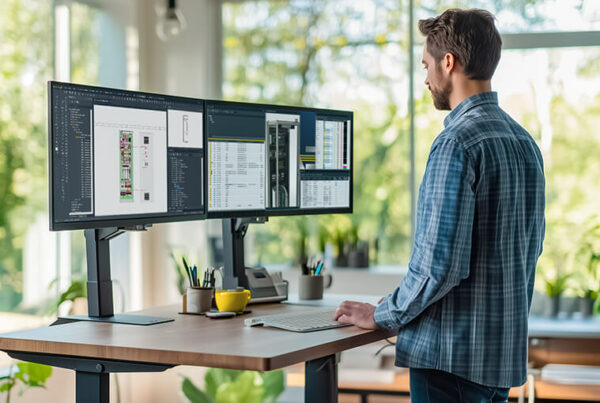
Efficient engineering from home:
How to master engineering in the home office
Working from a home office has become part of everyday life in many industries. For electrical designers too, this way of working not only creates new opportunities, but also challenges. Incorrectly organized, home office can also quickly lead to unhealthy routines, lack of exercise or irregular break and work times. Electrical engineers in particular also need access to licensed software such as WSCAD ELECTRIX for their work. In this article, we will provide you with valuable tips for balancing health and optimal work at home, as well as clarify technical issues such as the licence use of WSCAD ELECTRIX from the home office.
1. Create an optimal working environment in the home office
Flexible working hours, less commuting and a customizable work environment are just some of the benefits of working from home. However, this requires a work environment that enables productive and healthy work.
Ergonomic workplace
An ergonomically designed workplace contributes significantly to efficiency at work. Ergonomic means that the working environment is optimally adjusted to the person. An optimally adapted workstation prevents pain and tension and thus avoids back pain, slipped discs or foot malpositions.
The environment
Of course, it is best to have your own workroom. This way, you can work undisturbed and even after work, work can be clearly separated from leisure time. If you do not have your own study, the desk should be placed in a bright corner of the room and separated from the rest by curtains, plants or similar.
The light
In order not to strain the eyes unnecessarily and to avoid eye damage, good lighting conditions should be ensured. The desk should be located near a window to take advantage of natural daylight. The desk and monitor should be parallel to the window to avoid reflections or shadows. In the case of artificial lighting, care must be taken to ensure that the light source is sufficiently bright – the optimum illumination of the workplace is between 500 lux and 1,500 lux. In addition to brightness, light color also plays a role. For example, bluish, cold light tends to have an invigorating effect, while yellowish, warm light tends to have the opposite effect.
Table
The desk should be approx. 160 x 80 cm. The optimum height depends on body size and is between 65 and 85 cm, so that the arms rest loosely or are at armrest level. When standing, a 90-degree angle should apply to the upper and lower arms. A height-adjustable desk is ideal because it can be adjusted to accommodate body size, posture and work style. In addition, a height-adjustable desk allows you to change your posture more frequently, which reduces strain on your joints and helps your muscles.
Chair
An ergonomic office chair encourages movement and adapts to individual size and proportions. It should have an adjustable seat depth, armrests and a long backrest. The optimum seat height is achieved when the hip joints are higher than the knee joints and the upper and lower arms form a right angle. Alternatives to the classic office chair are active chairs or saddle chairs. The active chair has no backrest, encourages more movement and is height adjustable. The saddle chair provides a more upright position, relieves pressure on joints and improves respiratory and bowel function. The use of an exercise ball as a substitute for an office chair is not recommended, as it does not allow for height adjustment and is more likely to lead to poor posture.
Monitor and mouse
The monitor, keyboard and mouse should also be ergonomic, especially to relieve the forearm, neck and eyes.
Screen
The screen should be positioned at an appropriate height and distance, with the viewing distance depending on the size of the monitor (e.g. 80 cm for a 19-inch screen). With the upper body upright, the top edge of the screen should be at maximum eye level and slightly tilted back. The brightness of the screen depends on the brightness of the environment. A matte surface, good contrast and positive display (dark text on a light background) makes reading easier and prevents fatigue.
Ergonomic PC mice
Ergonomic mice are specially designed to support the natural posture of the hand and reduce strain on the muscles, nerves and connective tissue. So-called vertical mice promote a natural hand posture by tilting the hand sideways, allowing the forearm to rest at an angle. Conventional mice lead to recurring high tension in the forearm, as it is twisted during use and places incorrect strain on the arm and upper body.
Ergonomic keyboard
Ergonomic keyboards keep the wrist relaxed and thus prevent misalignments and tension. If an ergonomic keyboard is not available, a soft hand rest or tilting the keyboard backwards can help. The mouse and keyboard should also be placed closer to the body so that you don’t have to constantly reach for them. When primarily using the letter keys, the H key should be centrally located in front of the body and the wrist should be straight and aligned with the axis of the forearm.
Develop healthy routines
In order to work healthily and productively in the home office in the long term, it is important to integrate certain routines into the daily work routine. These help maintain work-life balance and stay mentally fit. Some important aspects of a healthy routine are:
Plan your day
Start each workday with a clear structure. Set a time for each day to start and end work. Don’t jump from bed to desk, but get ready as if you were going to the office. Of course, you don’t have to work at home in a suit, but neither should your pajamas.
Create a to-do list for the day to keep track of upcoming tasks and prioritize them according to their urgency and importance.
Set boundaries
Constantly mixing your private and work life can make you sick in the long run and lead to burn-out. It is therefore essential to clearly separate work and leisure. Define fixed working hours and stick to them – after work means after work. But efficient work also needs clear rules. Therefore, agree with your family and roommates how and when you may not be disturbed. This also works with older children – with younger children, you should make sure to set up shorter work blocks.
Take breaks
Working in a home office brings with it the danger of neglecting regular breaks – in the office, a walk to the coffee machine and a quick chat with colleagues leads to a little relaxation in between. So don’t forget to take regular breaks – both short and long ones. Use the time to relax physically and mentally, for example by taking a short walk or simply closing your eyes for a moment. By the way, wolfing down your lunch in front of the screen does not count as a break!
If you regularly forget to take breaks, set an alarm for a 5-minute break at least once an hour and mark your lunch as a fixed appointment in your calendar. This way, your colleagues will also see when you are unavailable.
Exercise
Sitting is the new smoking. So make sure you get enough exercise during the workday. Get up at least once an hour, stretch or do light exercises at your desk. This will promote circulation and help you stay focused. Again, it helps to set yourself a regular reminder.
Take care of your eyes
Be careful not to strain your eyes by regularly taking your eyes off your screen and looking into the distance. This will prevent fatigue and keep your eyes healthy.
There are apps that provide support in the home office
Often, we are so engrossed in our tasks or rushing from one meeting to the next that we forget to pause for a moment, stand up and give our eyes a break. Below are some examples of apps that help develop a healthy routine:
Take breaks
The free apps Time Out (Apple) or Work Break (Android) help you take regular breaks. You set a specific interval and the app then reminds you to take breaks – if you wish, it will also simply lock your screen during the break time.
Sports and relaxation
7 mind (Apple and Android) helps you wind down after work with relaxation and meditation exercises. The free app 7-Minuten (Android) offers office-suitable mini-workouts for an active break and the Windows tool Eyeleo reminds you at regular intervals to give your eyes a break from the PC and supports you with suitable small exercises.
2. Stay in contact with colleagues
Good communication not only promotes cooperation, but also strengthens the sense of community within the team. Here are two tips on how to stay in touch with your colleagues:
Pick up the phone more often: phone calls instead of emails
Emails are a quick and convenient way to communicate, but a personal phone call can often be more effective, especially in the home office. Through direct exchange, misunderstandings can be avoided and complex issues can be clarified more easily. In addition, talking on the phone also allows for a more emotional exchange, which helps strengthen the relationship with your colleagues even at a distance.
Arrange joint breaks: Virtual coffee breaks and lunch breaks.
Even if you work from home, shared breaks should still be part of your daily work routine. Arrange fixed times for virtual coffee breaks or lunches with your colleagues – this way you create space for informal exchanges and maintain team spirit despite physical separation. Use video conferencing tools such as Microsoft Teams to see each other and interact better.
3. Technical equipment: Using WSCAD ELECTRIX best in the home office
As an electrical designer, in addition to an optimal working environment, you also need special software solutions such as WSCAD ELECTRIX. Often the software solutions are license-bound. However, WSCAD ELECTRIX makes it surprisingly easy to work from your home office.
Borrow a network license locally
The use of WSCAD ELECTRIX is based on network licenses. For example, if a company has ten licenses for WSCAD ELECTRIX, ten users can use the software simultaneously. In most cases, the licenses are stored centrally on a company server.
For use in the home office, however, these licenses can easily be borrowed by the respective user locally on his computer. In our example, this means that a license is not stored centrally at the company, but locally on the user’s computer for a certain period of time. With local lending, therefore, no Internet connection to the license server is required to use the software.
Locally installed software, decentralized data
In WSCAD ELECTRIX, electrical designers often work together on plans. For smooth and fast collaboration from the home office, it is therefore advisable to install the software locally on the work PC and to access the data in the company network via a VPN.
If you are working alone on a project, it can also make sense to save the required data locally on the work computer and return the plans to the company network later.
Conclusion: Working successfully as an electrical designer in the home office
Working from a home office on a regular basis is here to stay – and with a well set up workstation, working from home in a productive and healthy way is no problem either. WSCAD provides uncomplicated support for electrical designers in this regard with the local loan of software licenses to provide the necessary work equipment for the home office.


